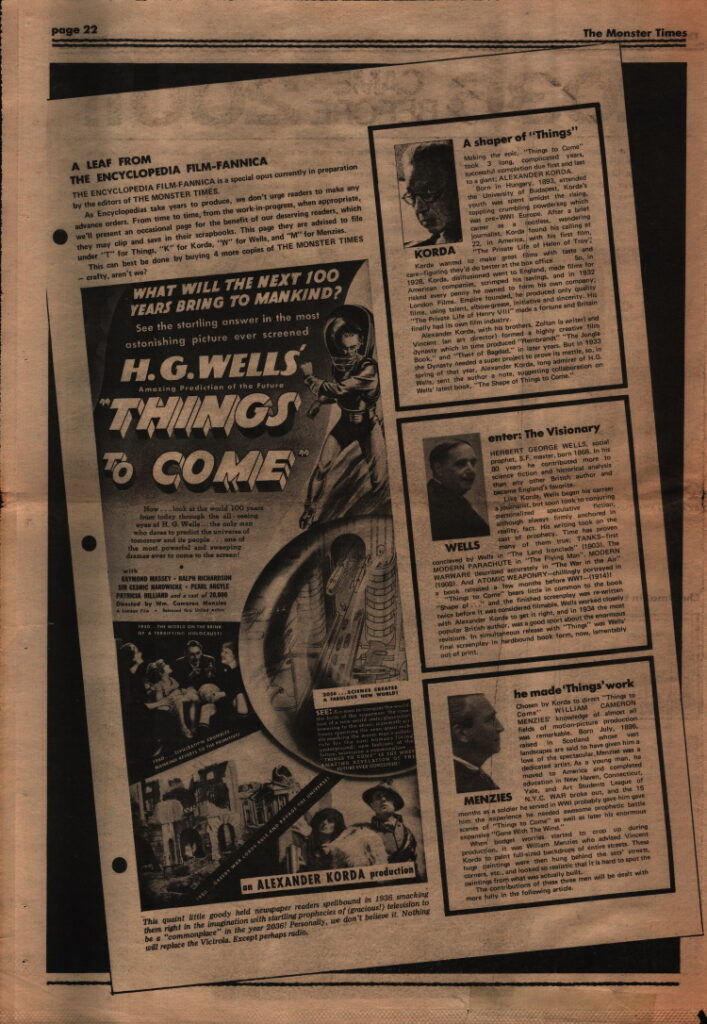
A LEAF FROM THE ENCYCLOPEDIA FILM-FANNICA THE ENCYCLOPEDIA FILM-FANNICA is a special opus currently in preparation by the editors of THE MONSTER TIMES.
As Encyclopedias take years to produce, we don’t urge readers to make any advance orders. From time to time, from the work-in-progress, when appropriate, we’ll present an occasional page for the benefit of our deserving readers, which “they may clip and save in their scrapbooks. This page they are advised to file under “T” for Things, “K” for Korda, “W” for Wells, and “M” for Menzies.
This can best be done by buying 4 more copies of THE MONSTER TIMES – crafty, aren’t we?
This quaint little goody held newspaper readers spellbound in 1936 smacking them right in the imagination with startling prophecies of (gracious!) television to be a “commonplace” in the year 2036! Persulisi we don’t believe it. Nothing will replace the Victrola. Except perhaps radio.
A shaper of “Things”
Making the epic, “Things to Come” took 3 long, complicated years, successful completion due first and last to a giant; ALEXANDER KORDA.
Born in Hungary, 1893, attended the University of Budapest, Korda’s youth was spent amidst the rising, toppling crumbling powder keg which was pre-WWI Europe. After a brief career as a rootless, wandering journalist, Korda found his calling at 22, in America, with his first film, “The Private Life of Helen of Troy“.
Korda wanted to make great films with taste and care-figuring they’d do better at the box office So, in 1928, Korda, disillusioned went to England, made films for American companies, scrimped his savings, and in 1932 risked every penny he owned to form his own company: London Films. Empire founded, he produced only quality films, using talent, elbow-grease, initiative and sincerity. His “The Private Life of Henry VIII” made a fortune and Britain finally had its own film industry.
Alexander Korda, with his brothers, Zoltan (a writer) and Vincent (an art director) formed a highly creative film dynasty which in time produced “Rembrandt” “The Jungle Book,” and “Theif of Bagdad,” in later years. But in 1933 the Dynasty needed a super project to prove its mettle, so, in spring of that year, Alexander Korda, long admirer of H.G. Wells, sent the author a note, suggesting collaboration on Wells’ latest book, “The Shape of Things to Come.”
enter: The Visionary
HERBERT GEORGE WELLS, social prophet, S.F. master, born 1866. In his 80 years he contributed more to science fiction and historical analysis than any other British author and became England’s favorite.
Like Korda, Wells began his career a journalist, but soon took to conjuring personalized speculative fiction, although always firmly anchored in reality, fact. His writing took on the cast of prophecy. Time has proven many of them true; TANKS-first conceived by Wells, in “The Land Ironclads” (1903). The MODERN PARACHUTE in “The Flying Man“. MODERN WARWARE described accurately in “The War in the Air” (1908). And ATOMIC WEAPONRY-chillingly portrayed in a book released a few months before WW1-(1914)!
“Things to Come” bears little in common to the book “Shape of…” and the finished screenplay was re-written twice before it was considered filmable. Wells worked closely with Alexander Korda to get it right, and in 1934 the most popular British author, was a good sport about the enormous revisions. In simultaneous release with “Things” was Wells’ final screenplay in hardbound book form, now, lamentably out of print.
he made ‘Things’ work
Chosen by Korda to direct “Things to Come” WILLIAM CAMERON MENZIES’ knowledge of almost all fields of motion-picture production was remarkable. Born July, 1896, raised in Scotland whose vast landscapes are said to have given him a love of the spectacular, Menzies was a dedicated artist. As a young man, he moved to America and completed education in New Haven, Connecticut, Yale, and Art Students League of N.Y.C. WAR broke out, and the 15 months as a soldier he served in WWI probably gave him the experience he needed awesome prophetic battle scenes of “Things to Come” as well as later his enormous expansive “Gone With The Wind.”
When budget worries started to crop up during production, it was William Menzies who advised Vincent Korda to paint full-sized backdrops of entire streets. These huge paintings were then hung behind the sets’ streets, corners, etc., and looked so realistic that it is hard to spot the paintings from what was actually built.
The contributions of these three men will be dealt with more fully in the following article.
